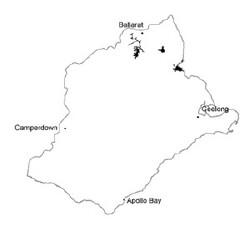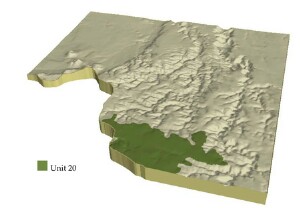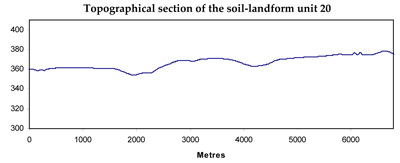Soil/Landform Unit 20
Landform Unit Description
Page top
 Gentle undulating sedimentary plains with many forested remants soulth of Lal Lal |
0.59% of CMA region The gently undulating plains occur near Napoleons, Lal Lal and Durdidwarrah are composed of Neogene fluvio-marine sand overlying Ordovician marine sandstone and shale. These sedimentary plains of the Western Uplands support a wide range of vegetation classes including forests and woodlands. Some of the major classes are plains Grassy Woodland, Heathy Dry Forest, Valley Grassy Forest, Damp Sands Herb-rich Woodland and Grassy Dry Forest. Dominant species are Callitris columellaris, Eucalyptus viminalis, E. obliqua, E. radiata, E. rubidia, E. ovata and E. pauciflora. The low fertility and low water holding capacity of the soils have discouraged further clearing. Soils include an association of bleached sandy mottled texture contrast soils or unbleached equivalents in better drained areas. Heavier surface textured soils may occur in drainage lines. These soils can be prone to gully erosion which is minor to moderate in severity in some cleared areas. |  |
 Grazing is the major land use for these plains |  |
 |
Component | 1 | 2 | 3 | 4 | 5 | 6 | 7 | 8 |
Proportion of soil-landform unit | 50% | 7% | 6% | 2% | 20% | 5% | 5% | 5% |
| CLIMATE Rainfall (mm) | Annual: 730 | |||||||
| Temperature (oC) | Minimum 7, Maximum 18 | |||||||
| Precipitation less than potential evapotranspiration | October-March | |||||||
| GEOLOGY Age and lithology | Neogene fluvial sand, Quaternary sand, gravel and minor basalt, Orodivician marine sandstone and gravel | |||||||
| Geomorphology | ||||||||
| LANDUSE | Uncleared: Nature conservation; hardwood; gravel extraction Cleared: Sheep and beef cattle grazing; cropping (cereal); gravel extraction | |||||||
| TOPOGRAPHY Landscape | Gently undulating sedimentary plains | |||||||
| Elevation range (m) | 334-502 | |||||||
| Local relief (m) | 3 | |||||||
| Drainage pattern | Dendritic | |||||||
| Drainage density (km/km2) | 2.6 | |||||||
| Landform | Undulating plains | Flat plains | Drainage lines | Lakeside sandridges associated with Lal Lal swamp | Undulting plains | Minor hill | ||
| Landform element | Well drained non-sandy areas | Poorly drained non-sandy areas | Low-lying areas | Long gentle slope | Crest | Dry exposed slope | Crest | |
| Slope and range (%) | 2 (1-3) | 0 (0-2) | 1 (1-3) | 3 (2-3) | 3 (3-9) | 2 (1-3) | 15 )10-35) | 3 (1-6) |
| Slope shape | Convex | Flat | Concave | Convex | Straight | Convex | Straight | Convex |
| NATIVE VEGETATION Structure | Low open forest-woodland | Low open forest-woodland | Low open forest-woodland | Open forest | Open forest | Open forest | Open forest | Open forest |
| Dominant species | Callitris columellaris, E. viminalis, E. obliqua, E. radiata, E. rubida, E. ovata, E. pauciflora | E. ovata | E. ovata | E. viminalis, E. radiata | E. viminalis, E. obliqua | E. obliqua, E. radiata | E. obliqua, E. dives, E. radiata, E. viminalis | E. obliqua, E. dives E. radiata, E. viminalis |
| SOIL Parent material | Unconsolidated gravel, sand and clay | Unconsolidated gravel, sand and clay | Unconsolidated gravel, sand and clay | Unconsolidated sand | In situ weathered sandstone and shale | In situ weathered sandstone and shale | In situ weathered sandstone and shale | In situ weathered sandstone and shale |
| Description (Corangamite Soil Group) | Mottled brown, grey or yellow texture contrast soil (13) | Yellow sand soils, uniform texture (8) | Mottled red, brown, grey or yellow texture contrast soils (26) | Mottled brown, grey or brown, grey or yellow texture contrast soils (25) | Shallow stony red and brown, grey or yellow gradational soil (25) | |||
| Soil type sites | CLRA54, BD10, CLRA58 | CLRA53, CLRA58 | ||||||
| Surface texture | Sandy clay loam to loamy sand | Clay loam | Clay loam, sandy clay loam | Sand | Clay loam | Loam to clay loam | Fine sandy loam | Gravelly loam |
| Permeability | Moderate | Low | Moderate | High | Moderate to low | High | High | High |
| Depth (m) | 2 | 2 | 2 | >2 | 0.8-1.8 | 0.5-1.0 | 2 | 0.5 |
| LAND CHARACTERISTICS, POTENTIAL AND LIMITATIONS | Hardsetting surfaces, dispersible subsoils and overland flow result in leaching of salts, sheet and rill erosion and gully erosion. | Hardsetting surfaces, dispersible subsoils and overland flow result in leaching of salts, sheet and rill erosion and gully erosion. | Hardsetting surfaces, dispersible subsoils and overland flow result in leaching of salts, sheet and rill erosion and gully erosion. | Low water and nutrient hilding capacity lead to leaching and fertility decline. | Harsetting surfaces, dispersible subsoils and overland flow result in leaching of salts, surface compaction, sheet and rill/gully erosion. | Hardsetting surfaces, dispersible subsoils and overland flow result in leaching of salts, surface compaction, sheet and rill/gully erosion. | Steep slopes, hardsetting surfaces and overland flow result in sheet and rill erosion and surface compaction. | Moderate hardsetting surfaces and overland flow result in sheet and rill erosion and surface compaction. |


